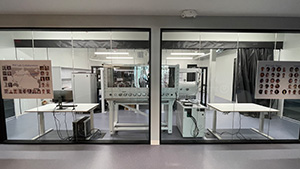 |
|
|
|
|
|
Feature Articles: NTT Research: Open Collaboration to Upgrade Reality Vol. 20, No. 1, pp. 23–25, Jan. 2022. https://doi.org/10.53829/ntr202201fa16 A New Lab Exploring Emergent Matter from LightAbstractIn September 2021, NTT Research unveiled its new smart workspace in Sunnyvale, California, called the NTT OneVision building. It is one of the first office buildings in Silicon Valley built for a post-pandemic vision of the workplace with collaboration-focused spaces, state-of-the-art health monitoring capabilities, and new layouts. The 35,100 square foot office building also contains a new optical laboratory for the NTT Research Physics & Informatics Laboratories (PHI Lab). The Sunnyvale optical lab supports multiple users and research themes. One specific design focus when planning the new lab was to provide ways to experimentally create and study many-body states of light, a specific example of which is the engineering of a bosonic fractional quantum Hall state using light. This article provides a brief review of our research agenda on quantum many-body states of light and details of the new lab. Keywords: optical lab, quantum many-body states, fractional quantum Hall effect 1. Research agendaIn traditional condensed matter platforms, the interactions between large ensembles of particles (such as electrons or atoms) lead to the emergence of fascinating new physical phenomena such as superconductivity, superfluidity and the fractional quantum Hall effect. Key to the most exotic of these emergent phases of matter is strong interactions between the constituent particles. While photons (particles of light) do not typically interact, advances in optical materials and hybrid-optical structures can also induce very strong non-linearity between photons. Furthermore, the ability to control photons to very precise, even single photon levels, in addition to more recent discoveries such as topological states of light, make optical platforms extremely exciting for the exploration of fundamentally new states of matter. Pursuing new optical platforms that strategically combine these and other properties, we aim to create and explore new many-body quantum states of light. In optics, there are many experimental platforms we might use, each of which has distinct features and advantages. Exciton-polaritons (bosonic half-light, half-matter quasi-particles in a semiconductor microcavity), for example, have the advantage of relatively strong interactions, a result of hybridizing cavity photons with interacting electronic excitations. This platform may be fabricated using a variety of materials and structures, also with spatial structuring and even topological phases. Meanwhile, implementation of topological models in a time-multiplexed optical resonator network (a similar geometry to the coherent Ising machine) is a distinct methodology with the unique feature of being able to engineer non-local interactions, which makes this also an exciting platform to study in the context of lattice bosonic quantum Hall effects. The breadth of photonic-platform exploration is enhanced by strategic partnerships with external institutions, including California Institute of Technology, Massachusetts Institute of Technology, Stanford University and RIKEN – a major scientific research institute in Japan. Of course, much of our work will take place at Sunnyvale. Some of the fundamental problems we are seeking to initially explore in the new optical lab include the following: 1. How can photons be made to interact (very) strongly – to the level at which strong correlations and new physical phenomena result? 2. How can we induce a large artificial magnetic field for neutral photons, and use this to create topological states of light? 3. What new quantum states of matter and other phenomena might result from highly non-linear, structured photonic systems? Pursuing our research agenda requires precise optical control, extreme conditions, including low temperatures and large magnetic fields, as well as advances in materials and innovative device design. Our Sunnyvale laboratory is uniquely positioned to approach these challenges, combining in the same space advanced material and device fabrication with ultra-low temperatures, high magnetic fields, and new schemes for optical manipulation and measurement. 2. Optical lab features and capabilitiesThe main lab area is about 35 feet x 33 feet, with a very high ceiling, which is useful for installing and operating larger equipment, such as our 11-foot-tall dilution fridge. The room is divided into three parts with retractable optical blackout curtains separating the sections. Two sections, which may each be independently and completely blacked out, are host to two distinct experimental research themes, while the other room will always be lit and used for discussions, data analysis, sample preparation, etc. There were many design requirements incorporating a range of Physics & Informatics Laboratories (PHI Lab) experiments, and it was necessary to make numerous accommodations. The combination of research projects together had strict requirements, necessitating design of custom HVAC (heating, ventilation, and air conditioning) systems, noise isolation for pumps and compressors, and removal of all magnetic materials from sections of the room. Some of the lab’s notable features and capabilities include the following:
3. Flexible and focusedAs with any new experimental optics laboratory, we needed to make sure the Sunnyvale lab was not too specific to be flexible with the exploratory nature and changing directions of the research projects. We have a well-balanced set of complimentary and cutting-edge equipment and apparatus, the combination of which is unique and offers us the ability to conduct entirely new experiments and work with as-yet unstudied but promising materials, of which only this apparatus is capable. For the specific themes discussed in this article, the exploration and creation of quantum many-body states in optical platforms is enabled through the development of new techniques, new materials, new theory, and by innovative design of experiments. We are gradually building a toolbox of experimental techniques, materials and device designs that will give us further opportunities to create fundamentally new states of matter with optics. |


